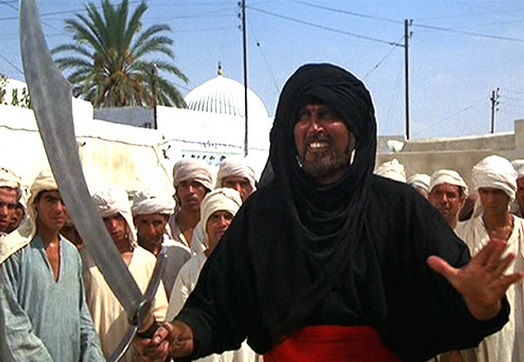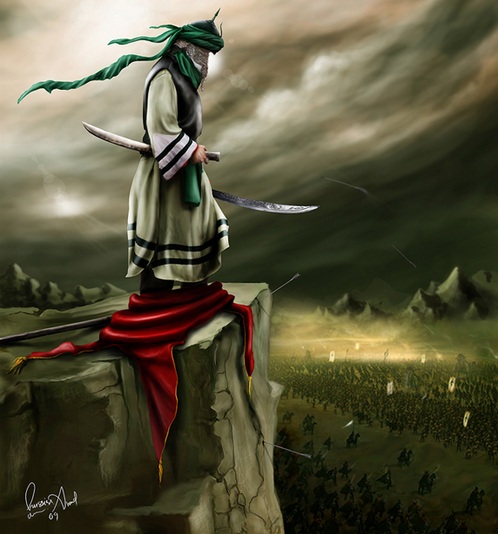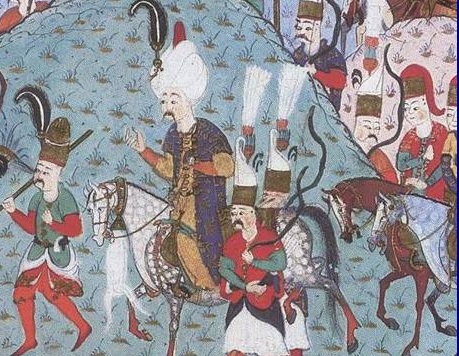  |
 |
 |
 |
|
MahdiWatch.org
|
 |
|
Home | About Me | Links to My Articles | Info on My Books | Contact Me
|
 |
|
Welcome to MahdiWatch.org! NEWSFLASH! COMMENTS LINK
BELOW EACH POST IS ENABLED! FEEL FREE TO BURY ME, PRAISE ME--OR JUST ISSUE A PERSONAL FATWA!
al-Mahdi is "the rightly-guided one" who, according to Islamic Hadiths (traditions),
will come before the end of time to make the entire world Muslim. Over the last 1400 years numerous claimants to the
mantle of the Mahdi have arisen in both Shi`i and Sunni circles. Modern belief in the coming of the Mahdi has
manifested most famously in the 1979 al-`Utaybi uprising of Sa`udi Arabia, and more recently in the ongoing
Mahdist movements (some violent) in Iraq, as well as in the frequently-expressed public prayers of former Iranian
President Ahmadinezhad bidding the Mahdi to return and, in the larger Sunni Islamic world, by claims that Usamah bin Ladin
might be the (occulted) Mahdi. Now in 2014 Mahdism is active in Syria, as the jihadist opposition group Jabhat al-Nusra
claims to be fighting to prepare the way for his coming; and in the new "Islamic State/caliphate" spanning
Syrian and Iraqi territory, as its leadership promotes the upcoming apocalyptic battle with the West at Dabiq, Syria. This site will track such Mahdi-related movements, aspirations, propaganda and beliefs in both Sunni and Shi`i
milieus, as well as other Muslim eschatological yearnings.
For a primer
on Mahdism, see my 2005 article, "What's Worse than Violent Jihadists?," at the History News Network: http://hnn.us/articles/13146.html; for more in-depth info, see the links here to my other writings, including my book on Mahdism.
|
|
|
|
Monday, November 11, 2013
Days of Future Mahdism Have Not Passed
Some time back I was asked by a friend/follower
on Twitter about scenarios that could lead to a Mahdist movement taking power somewhere in the modern Muslim world.
I will now attempt to construct a plausible set of circumstances that would encompass a Mahdi claim
being taken seriously by a sufficient number of Muslims such that it would become a political and military movement.

First, for the scoffers, let me adduce (again)
the 2012 empirical polling data from Pew, “The World’s Muslims: Unity and Diversity.” The data on Mahdism in particular I broke down for History News Network last year, pointing out, inter alia, the following crucial data: some 42% of Muslims (surveyed
in 23 countries) expect the “imminent” appearance—meaning in their lifetimes—of the Mahdi.
In actual numbers, that amounts to about 670 million Muslims. Belief in the Mahdi’s coming
is highest in: Afghanistan, 83%; Iraq, 72%; Turkey, 68%; Tunisia, 67%; Malaysia, 62%; Pakistan, 60%; Lebanon, 56%; Morocco,
51%; Palestinian territories, 46%; and Egypt, 40%. So much for the academic theory that Mahdism is just
a medieval holdover in Islam, held by only the uneducated and marginal; on the contrary, Mahdism is quite strong in the Islamic
world, across sectarian lines—for of the 10 countries listed above, only two (Iraq and Lebanon) are majority Shi`i;
the rest are predominantly Sunni.
Mahdism , then, is as
potent a belief in the Muslim world today as it ever has been—although in the past it tended to take reified form (both
Sunni and Shi`i) more often and, if not always more successfully—certainly often violently.
For example, Ibn Tumart (d. 1130 AD) claimed to be the Mahdi and created a movement that conquered much of what is
now Morocco, Algeria, Tunisian and Spain. The Isma’ili Shi`is took over Egypt in the 10th century
AD and their Imam-Caliphs ruled it, as well as much of the Maghrib and even the Hijaz, until Salah al-Din ended that dynasty
in 1171. Muhammad Ahmad (d. 1885) of Sudan is perhaps the most well-known Mahdi in history, thanks to Winston
Churchill’s The River War and the movie Khartoum. The Ottoman Empire was bedeviled, over the centuries, by dozens of chaps (usually Sufi mystics) who believed themselves to be the Mahdi and led rebellions
(as, for that matter, was true of the Sudanese Mahdi—legally an Ottoman subject and a Sufi, too). One
self-styled Mahdi even cropped up in Republican Turkey in 1930. Twelver Shi`i Mahdism was a major impetus
for Ayatollah Khomeini’s revolution in Iran in 1979—but it was also, the same year, the motivation for the Mahdist
revolution manqué of Juhayman al-`Utaybi (d. 1980) and his messianic brother-in-law Muhammad al-Qahtani (d. 1979) in
Saudi Arabia. But since
1979, Mahdist movements have seemed rather puny by comparison. The Islamic Republic of Iran remains the
only state purveyor of the belief system. On the non-state side, Iraq (post-US occupation) has seen the
rise of not just Muqtada al-Sadr’s Jaysh al-Mahdi [Army of the Mahdi] and its even more violent offshoot Asa’ib
Ahl al-Haqq [Battalions of the Family of Truth] but also, albeit less known: Ansar al-Mahdi
[Helpers of the Mahdi], the extremely jihadist Jund al-Sama’ [Army of Heaven] and the more benevolent Jaysh
Husayn [Army of Husayn]. JaM has become a political force in Iraq, and JaS engaged
in combat with US and Iraqi government forces—but neither came close to taking power, either via the ballot box or the
gun. Non-state Mahdist movements exist, as well, in Morocco (also called Ansar al-Mahdi) and in
Kyrgyzstan (another Jaysh al-Mahdi). Solo, free-lance Islamic messiahs have also proliferated
in Saudi Arabia in the last few years—much to the chagrin of the establishment, quite paranoid (with good reason) about
Mahdism since al-`Utaybi and his men occupied the Great Mosque of Meccas for three weeks in 1979. Nigeria
saw a Mahdist movement known as Yan Tatsine between WWII and the late 1970s. Several
Mahdist Muslims have arisen and developed followings in India and Pakistan since 1947 (as Yoginder Sikand
details in Pseudo-Messianic Movements in Contemporary South Asia, Global Media Publications, 2008). Even
Turkey is home to a non-jihadist strain of Mahdism, developed by Adnan Oktar, a.k.a. “Harun Yahya,” whose followers
claim that his esposual and re-working of Said Nursi’s (d. 1960) Sufi Lite metaphysic makes him the true Mahdi.
Mahdism’s path to power has three stages (according to Jan-Olaf
Blichfeldt, Early Mahdism: Politics and Religion in the Formative Period of Islam, Brill, 1985): 1) disseminating
revivalist propaganda aimed at undermining an extant (Islamic) regime; 2) forming a renegade “military theocracy”
and attempting to seize power; and 3) conquering, or forming separately, a territorial state based on Mahdist beliefs—one
that eventually wanes in ideological fervor and is supplanted or conquered in turn (albeit sometimes after a number of years).
Many pre-modern movements made it to levels one or two, and some—Ibn Tumart, the Sudanese Mahdi, others on a
smaller scale—even reached level three. Since 1979, however,
no Mahdist movement has made it past the second level (al-`Utaybi’s), and most have been stymied at the first (the aforementioned
groups in Iraq, Morocco and Kyrgyzstan; and the authors of reams of pro-Mahdist books, articles and websites).
For a modern Mahdist movement to gain ground among Muslims as not just an abstract belief system but a concrete political
and/or military movement, reaching Blichfeldt’s third stage, it would seem that it would need to win support in one
(or more) of the following: 1) a state; 2) a transnational organization; and/or 3) a terrorist organization.
Other than the Islamic Republic of Iran, where Twelver Shi`ism
is the regnant ideology but which—because of Sunni antipathy—is limited in the reach of its Mahdist da`wah
(“summons, propaganda”) to Yemen, Azerbaijan, Lebanon and a few pockets elsewhere, state Mahdism faces at best
slim prospects. (And even in Iran, no one dares claim to be the Mahdi, because to do so would shatter the
future hope of the Twelfth Imam’s return which is the regime’s raison d’être. )
Although a man claiming to be the Mahdi ran for the Egyptian Presidency last year, and a number of self-styled
Mahdis have announced themselves in Saudi mosques in the last several years, it’s hard to envision a scenario in which
a Mahdi claimant could first win an election, or seize control, in a major Sunni Muslim nation-state. His path to power would probably start in a non-state venue.

Ottoman Sultan Suleyman, the last major Sunni leader to be thought the Mahdi.
What about the transnational
organizations with an Islamic bent? I would submit that the four major ones are the
Organization of Islamic Cooperation, the Muslim Brotherhood, Hizb al-Tahrir and the obscure, but quite influential, Tablighi Jama`at. The
OIC is the Islamic “UN,” if you will (and, indeed, is the world’s second-largest transnational organization,
behind only the UN itself)—and that organization’s potential as the springboard to a new caliphate has already been examined. The Muslim Brotherhood is the Sunni Muslim world’s foremost Islamist political movement, primarily—but not solely—Arab.
Hizb al-Tahrir, or “Party of Liberation,” is a transnational movement to resurrect the caliphate (Sunni Muslim rule under one
man) which is banned in many countries (but not the US) as a terrorist group. And Tablighi Jama`at is an ostensibly non-political Islamic re-pietization movement which began in India but has spread to
many countries of the world and is said to have as many as 80 million members. The OIC is dominated by
men who strive for (greater) Islamic unity, and long for the days when “Islamdom” was the only global counterweight
to the West’s “Christendom”—but these are decidedly non-mystical and non-messianic, and so any attempt
by a self-styled Mahdi to have himself elected Secretary-General of this organization would likely falter as the elector Foreign
Ministers either fell out of their chairs laughing or ran to reach for their decorative daggers and scimitars.
The MB, unlike the OIC, is a popular, conservative grass-roots Sunni (mainly Arab) movement that aims for Islamic unity
and polity via re-Islamizing society from the ground up; as such, and following its founder Hassan al-Banna (d. 1949) and
his “apostle” Sayyid Qutb (d. 1966), the MB has little tolerance for Sufi mysticism—the usual provenance
of Mahdism. One can hardly imagine an Islamist technocrat like Muhammad Morsi adopting Mahdist beliefs.
Whereas the OIC works at the rarefied Foreign Ministry level between Islamic states and the MB does so via the more
mundane local political processes within Islamic countries, HT strives to do a bit of both, albeit sans any official state
blessing (and, indeed, often outright state opposition and repression). HT has tried
declaring a caliphate—as in, for example, Zanzibar—then hoping that Muslims would jump on the bandwagon and lobby
for it to replace the extant government; alas for them, such has not yet come to pass. Still, the group
is active in many countries (including the US) and continues to churn out theoretical tracts, and hold conferences, on how
a caliphate might be (re)constructed. And a caliphate would be a very plausible platform for a self-proclaimed
Mahdi to appropriate. TJ is the most far-reaching and arguably influential transnational Islamic organization,
rather akin to the Catholic Church’s Opus Dei program for revitalizing the laity’s faith and putting it into action.
It has been deemed by some a “conveyor belt” to terrorism—but this is true only insofar as TJ is
a path to stricter adherence to more conservative, indeed fundamentalist, Islamic norms (see my article on this topic). Unlike the MB, however, TJ is not totally opposed to Islamic mysticism, and even incorporates
some Sufi practices (such as dhikr, “remembrance” of Allah via repetitive prayers) into its program.
A charismatic, mystically-oriented Muslim leader with Mahdist aspirations is probably more likely to emerge from TJ’s
ranks than from any of these other organizations. If such a man were to bridge the gap between TJ and HT,
wedding the former’s piety, Muhammadan emulation and transnational reach to the latter’s political program, zeal
and activism—then a non-state caliphate with a Mahdi in charge is possible. Both
are Sunni, too, so neither could accuse the other of heretical Shi`ism. The biggest obstacle to a
TJ-HT Mahdiyah would be HT’s technocratic bent (akin to that of the MB), which could conceivably be overcome by its
zeal for one-man Islamic rule; possible since a Mahdi would be a super-caliph, and thus—perhaps—acceptable.
What of the legions of Muslim terrorist groups? Would any of them be amenable to Mahdism?
Many are Salafi/Wahhabi or MB, and most Muslims of that bent are ardently opposed to mystical Islam
and thus, presumably, to Mahdism. But the gap between Salafis and Sufis can be overstated—it is not
always absolute. In the past Sufis waged some of the most violent jihads in history, and many Sunni Mahdis
came from Sufi contexts (because of the orders’ penchant for charismatic leadership and extant quasi-military organization).
Even today some Sufi orders, such as the Qadiris, often agree with the Salafis on the
importance of shari`ah and Islamic government. Others, like the Naqshbandis, have historically
been fond of waging jihad against Islam’s enemies. And a fusion of Sufism with Salafism or MB ideas
has been attempted before, as by Sa’id Hawwa (d. 1989), a Syrian Naqshbandi Sufi who also belonged to the MB and envisioned
the Naqshbandi order as the spiritual guide for the politically-active MB and, more relevantly for the issue at hand, that
jihad should be off-limits until the caliphate’s reestablishment. At least one Sufi terrorist group
exists (Iraq’s Jaysh Rijal al-Tariqah al-Naqshbandiyah [Army of the Men of the Naqshbandi Order]) and many
more of them have strong eschatological doctrines—such as the Haqqani offshoot of the Naqshbandiyah. On
the Salafi side, at least some of those groups have been infused with eschatological and Mahdist fervor—as, for example,
Jabhat al-Nusra [Support Front] in Syria, whose members already view that country’s civil war as the precursor to the End Time events of the Islamic hadiths. And at least 10 of the groups on the State Department terrorist
organization list claim to be fighting to reestablish a caliphate: all the al-Qa`idah [AQ] affiliates; Abu Sayyaf (Philippines);
Lashkar-e Taiba (South Asia); Jemaah Islamiyah (Southeast Asia); Harakat ul-Jihad-i-Islami (Bangladesh); al-Shabab (East Africa);
Indian Mujahidin; and most likely the Abdullah Azzam Brigades (transnational). This
is not Mahdism per se, but as aforementioned with HT any desires for one-man Islamic rule are ipso facto complementary
to Mahdism, which, essentially, constitutes an eschatological one-man polity. AQ members
reportedly held mystical, if not Mahdist, veneration for Usama bin Ladin (see my book Holiest Wars, pp. 156ff).
A future AQ leader, who manages to plan and execute an even more “successful” attack on the US or Israel
than 9/11—say, via a nuclear weapon—might gain caliphal or even Mahdist cachet sufficient to bring together not
only a number of terrorist groups but perhaps even the like of HT and TJ. It might be a “virtual
Mahdiyah” with no geographic center and a peripatetic leader—but a sort of transnational, messianic entity nonetheless,
commanding the political and religious loyalty of tens (or hundreds) of millions of Muslims and having a ready-made military
wing in several Islamic terrorist organizations. Such a leader might even be able to draw support, if not
allegiance, from Twelver Shi`i groups like Lebanon’s Hizbullah or the various ones in Iraq, if he were to adduce a genealogy
that included any of the Twelver Shi`i Imams (such as was done by the 15th century AD Indian Mahdi, Sayyid Jawnpuri, who although
Sunni claimed descent from Musa al-Kazim, the seventh Imam).

Logo of the "Army of the Men of the Nasqshbandiyah Order:" "With the help
of Allah, Victory is Near!"
Mahdism is, historically, closely tied to belief in the mujaddid, the “renewer”
of Islam predicted in several hadith to come every 100 years; thus, eschatological expectations in Islam have tended to skyrocket
as the turn of each Muslim century approaches, as was the case in 1979 (al-`Utaybi), 1881 (the Sudanese Mahdi), etc.
The year 1500 AH (After Hijra) will occur in 2076 AD. Couple that with the empirical data
from Pew indicating strong eschatological beliefs among many Muslims, the global Islamic community’s growing sense of
victimization at the hands of the Christian West (and Russia), the burgeoning influence of transnational Islamic movements
like the pious TJ and political HT, as well as the continued (indeed, flourishing) popularity and power of jihad-waging terrorist
groups—and the emergence of a political and/or military Mahdist movement in the coming decades appears to be a good
bet.
.:
Bottom line: An alliance of non-state groups like TJ and/or HT with AQ Central (and very possibly the South Asian terrorist
organizations) naming one man as caliph, who then reveals that he also considers himself the Mahdi, is the most likely path
to modern Mahdism. Such a hypothetical movement would be powerful and dangerous enough if it merely
stalled at the renegade military theocracy stage. Should this new Mahdi and his followers gain the support
of (or take over) an extant Muslim-majority state (Egypt? Turkey? Post-Saudi Arabia?), moving into stage three of political
Mahdism, the world would have its hands full—especially were he to do so where he would gain a nuclear arsenal, such
as in Pakistan. I won’t be around in 2076, but my boys’ (and grandchildrens’?)
celebration of the American Tricentennial might well be tempered by the threat of an Islamic Mahdi.
12:09 pm est
|
|
|
|
| Jamkaran Mosque near Qom, Iran (during my trip there Aug. 2008) |
|
|
|
